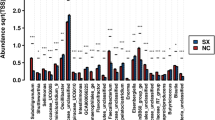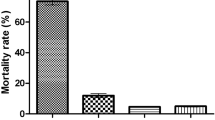Abstract
The use of glyphosate modifies the environment which stresses the living microorganisms. The aim of the present study was to determine the real impact of glyphosate on potential pathogens and beneficial members of poultry microbiota in vitro. The presented results evidence that the highly pathogenic bacteria as Salmonella Entritidis, Salmonella Gallinarum, Salmonella Typhimurium, Clostridium perfringens and Clostridium botulinum are highly resistant to glyphosate. However, most of beneficial bacteria as Enterococcus faecalis, Enterococcus faecium, Bacillus badius, Bifidobacterium adolescentis and Lactobacillus spp. were found to be moderate to highly susceptible. Also Campylobacter spp. were found to be susceptible to glyphosate. A reduction of beneficial bacteria in the gastrointestinal tract microbiota by ingestion of glyphosate could disturb the normal gut bacterial community. Also, the toxicity of glyphosate to the most prevalent Enterococcus spp. could be a significant predisposing factor that is associated with the increase in C. botulinum-mediated diseases by suppressing the antagonistic effect of these bacteria on clostridia.
Similar content being viewed by others
References
Barja BC, Herszage J, Afonso MD (2001) Iron(III)–phosphonate complexes. Polyhedron 20:1821–1830
Barry G, Padgette SR (1992) Glyphosate tolerant 5-enolpyruvylshikimate-3-phosphate synthases. World Patent, WO 92/04449
Baums CG, Schotte U, Amtsberg G, Goethe R (2004) Diagnostic multiplex PCR for toxin genotyping of Clostridium perfringens isolates. Vet Microbiol 20:11–16
Benachour N, Se′ralini GE (2009) Glyphosate formulations induce apoptosis and necrosis in human umbilical, embryonic, and placental cells. Chem Res Toxicol 22:97–105
Benachour N, Sipahutar H, Moslemi S et al (2007) Time- and dose-dependent effects of Roundup on human embryonic and placental cells. Arch Environ Contam Toxicol 53:126–133
Benedetti AL, Vituri Cde L, Trentin AG et al (2004) The effects of sub-chronic exposure of Wistar rats to the herbicide Glyphosate-Biocarb. Toxicol Lett 153:227–232
Beuret CJ, Zirulnik F, Gimenez MS (2005) Effect of the herbicide glyphosate on liver lipoperoxidation in pregnant rats and their fetuses. Reprod Toxicol 19:501–504
Bezkorovainy A (2001) Probiotics: determinants of survival and growth in the gut. Am J Clin Nutr 73:399–405
Bonnet JL, Bonnemoy F, Dusser M et al (2007) Assessment of the potential toxicity of herbicides and their degradation products to nontarget cells using two microorganisms, the bacteria Vibrio fischeri and the ciliate Tetrahymena pyriformis. Environ Toxicol 22:78–91
Bradshaw LD, Padgette SR, Kimball SL et al (1997) Perspectives on glyphosate resistance. Weed Technol 11:189–198
Burr DH, Sugiyama H, Jarvis G (1982) Susceptibility to enteric botulinum colonization of antibiotic treated adult mice. Infect Immun 36:103–106
Cerdeira AL, Duke SO (2006) The current status and environmental impacts of glyphosate-resistant crops: a review. J Environ Qual 35:1633–1658
Clair E, Linn L, Travert C et al (2012) Effects of Roundup and glyphosate on three food microorganisms: Geotrichum candidum, Lactococcus lactis subsp. cremoris and Lactobacillus delbrueckii subsp. bulgaricus. Curr Microbiol 64:486–491
Coelho Abrantes M, MdF Lopes, Kok J (2011) Impact of manganese, copper and zinc ions on the transcriptome of the nosocomial pathogen Enterococcus faecalis V583. PLoS ONE 6(10):e26519. doi:10.1371/journal.pone.0026519
De Roos AJ, Svec MA, Blair A, Rusiecki JA et al (2005) Glyphosate results revisited: respond. Environ Health Perspect 113:366–367
Duke SO, Baerson SR, Rimando AM (2003) Herbicides: glyphosate. In: Plimmer JR, Gammon DW, Ragsdale (eds) Encyclopedia of agrochemicals. http://www.mrw. Accessed June 2012
EFSA (2009) The community summary report on trends and sources of zoonoses and zoonotic agents in the European Union in 2007. EFSA J 223:1–320
Eschenburg S, Healy ML, Priestman MA et al (2002) How the mutation glycine96 to alanine confers glyphosate insensitivity to 5-enolpyruvyl shikimate-3-phosphate synthase from Escherichia coli. Planta 216:129–135
FAO (2005) Pesticide residues in food. http://www.fao.org/docrep/009/a0209e/a0209e0d.htm. Accessed June 2012
Gasnier C, Dumont C, Benachour N et al (2009) Glyphosate based herbicides are toxic and endocrine disruptors in human cell lines. Toxicology 262:184–191
Gong J, Forster RJ, Yu H et al (2002) Diversity and phylogenetic analysis of bacteria in the mucosa of chicken ceca and comparison with bacteria in the cecal lumen. FEMS Microbiol Lett 208:1–7
Havenaar R, Huis JHJ, in’t Veld JHJ (1992) Probiotics: a general view. In: Brian J, Wood B (eds) Lactic acid bacteria. Elsevier Applied Science, London, pp 171–192
Hernando MD, De Vettori S, Martinez Bueno MJ et al (2007) Toxicity evaluation with Vibrio fischeri test of organic chemicals used in aquaculture. Chemosphere 68:724–730
Houf K, Stephan R (2007) Isolation and characterization of the emerging foodborne pathogen Arcobacter from human stool. J Microbiol Methods 68:408–413
IFEN (2006) Report on pesticides in waters. Data 2003–2004
Isolauri E, Sutas Y, Kankaanpaa P et al (2001) Probiotics: effects on immunity. Am J Clin Nutr 73:444–450
Kishore GM, Shah DM (1988) Amino acid biosynthesis inhibitors as herbicides. Annu Rev Biochem 57:627–663
Klaenhammer TR (1993) Genetics of bacteriocins produced by lactic acid bacteria. FEMS Microbiol Rev 12:39–86
Kleessen B, Elsayed NAAE, Loehren U et al (2003) Jerusalem artichokes stimulate growth of broiler chickens and protect them against endotoxins and potential cecal pathogens. J Food Prot 66:2171–2175
Krüger M, Große-Herrenthy A, Schrödl W et al (2012) Visceral botulism at dairy farms in Schleswig Holstein, Germany—prevalence of Clostridium botulinum in faeces of cows, in animal feeds, in faeces of the farmers, and in house dust. Anaerob 18(2):221–223
Kwan PS, Birtles A, Bolton FJ, French NP, Robinson SE et al (2008) Longitudinal study of the molecular epidemiology of C. jejuni in cattle on dairy farms. Appl Environ Microbiol 74:3626–3633
Lancaster SH, Hollister EB, Senseman SA, Gentry TJ (2010) Effects of repeated glyphosate applications on soil microbial community composition and the mineralization of glyphosate. Pest Manag Sci 66:59–64
Lorenzatti E, Maitre MI, Argelia L, Lajmanovich R, Peltzer P, Anglada M (2004) Pesticide residues in immature soybeans of Argentina croplands. Fresenius Environ Bull 13:675–678
Meremäe K, Roasto M, Tamme T, Ivanova M, Liisa M et al (2010) In-vitro-Studie über die antimikrobielle Wirkung von ausgewählten Probiotika kombiniert mit Präbiotika auf Campylobacter jejuni. Archiv für Lebensmittelhygiene 61(4):125–164
Missous G, Thammavongs B, Dieuleveux V et al (2007) Improvement of the cryopreservation of the fungal starter Geotrichum candidum by artificial nucleation and temperature down shift control. Cryobiology 55:66–71
Moore JE, Corcoran D, Dooley JSG, Fanning S, Lucey B et al (2005) Campylobacter. Vet Res 36:351–382
Motekaitis RJ, Martell AE (1985) Metal chelate formation by N-phosphonomethylglycine and related ligands. J Coord Chem 14:139–149
Mulder RWAW, Havenaar R, Huis in’t Veld JHJ (1997) Intervention strategies: the use of probiotics and competitive exclusion microfloras against contamination with pathogens in pigs and poultry. In: Fuller R (ed) Probiotics 2: application and practical aspects. Chapman & Hall, London, pp 187–207
Oliveira AG, Telles LF, Hess RA et al (2007) Effects of the herbicide Roundup on the epididymal region of drakes Anas platyrhynchos. Reprod Toxicol 23:182–191
Paganelli A, Ganso V, Acosta H et al (2010) Glyphosate-based herbicides produce teratogenic effects on vertebrates by impairing retinoic acid signaling. Chem Res Toxicol 23:1586–1595
Parente E, Hill C (1992) Characterization of enterocin 1146, a bacteriocin from Enterococcus faecium inhibitory to Listeria monocytogenes. J Food Protect 55:497–502
Parente E, Hill C (1992) Inhibition of Listeria in buffer, broth, and milk by enterocin 1146, a bacteriocin produced by Enterococcus faecium. J Food Protect 55:503–508
Peruzzo P, Porta A, Ronco A (2008) Levels of glyphosate in surface waters, sediments and soils associated with direct sowing soybean cultivation in north pampasic region of Argentina. Environ Pollut 156(1):61-66. ISSN 0269-7491
Poletta GL, Larriera A, Kleinsorge E, Mudry MD (2009) Genotoxicity of the herbicide formulation Roundup (glyphosate) in broad-snouted caiman (Caiman latirostris) evidenced by the Comet assay and the micronucleus test. Mutat Res 672:95–102
Priestman MA, Funke T, Singh IM et al (2005) 5-Enolpyruvylshikimate-3-phosphate synthase from Staphylococcus aureus is insensitive to glyphosate. FEBS Lett 579:728–732
Relyea RA (2005) The impact of insecticides and herbicides on the biodiversity and productivity of aquatic communities. Ecol Appl 15:618–627
Sanchís J, Kantiani L, Llorca M, Rubio F et al (2012) Determination of glyphosate in groundwater samples using an ultrasensitive immunoassay and confirmation by on-line solid-phase extraction followed by liquid chromatography coupled to tandem mass spectrometry. Anal Bioanal Chem 402(7):2335–2345
Schmatz DM, Crane MS, Murray PK (1984) Purification of Eimeria sporozoites by DE-52 anion exchange chromatography. J Protozool 31(1):181–183
Shehata AA, Schrödl W, Krüger M (2012) Glyphosate suppresses the antagonistic effect of Enterococcus spp. on Clostridium botulinum Anaerobe. In: Tagung der Fachgruppe Bakteriologie und Mykologie, Leipzig, Germany, DVG, pp 181–182
Shehata AA, Schrödl W, Neuhaus J, Krüger M (2012) Antagonistic effect of different bacteria on Clostridium botulinum types A, B, C, D and E in vitro. Vet Record J (accepted)
Smith GR, Milligan RA (1979) Clostridium botulinum in soil on the site of the former Metropolitan (Caledonian) cattle market. J Hyg Camb 83:241–273
Solomon KR, Anadón A, Carrasquilla G et al (2007) Coca and poppy eradication in Colombia: environmental and human health assessment of aerially applied glyphosate. Rev Environ Contam Toxicol 190:43–125
Stalker DM, Hiatt WR, Comai L (1985) A single amino acid substitution in the enzyme 5-enolpyruvylshikimate-3-phosphate synthase confers resistance to the herbicide glyphosate. J Biol Chem 260:4724–4728
Sullivan NM, Mills DC, Riepmann HP et al (1988) Inhibition of growth of Clostridium botulinum by intestinal microflora isolated from healthy infants. Microb Ecol Health Dis 1:179–192
Thammavongs B, Denou E, Missous G et al (2008) Response to environmental stress as a global phenomenon in biology: the example of microorganisms. Microbes Environ 23:20–23
Tomley F (1997) Techniques for isolation and characterization of apical organelles from Eimeria tenella sporozoites. Methods 13:171–176
Wang Y, Sugiyama I (1984) Botulism in metronidazole-treated conventional adult mice challenged orogastrically with spores of Clostridium botulinum type A or B. Infect Immun 46:715–719
WHO (1994) Glyphosate, Environmental Health Criteria 159 http://www.inchem.org/documents/ehc/ehc/ehc159.htm#SubSectionNumber:4.1.6. Accessed Nov 2012
Yousef MI, Salem MH, Ibrahim HZ et al (1995) Toxic effects of carbofuran and glyphosate on semen characteristics in rabbits. J Environ Sci Health B 30:513–534
Author information
Authors and Affiliations
Corresponding author
Rights and permissions
About this article
Cite this article
Shehata, A.A., Schrödl, W., Aldin, A.A. et al. The Effect of Glyphosate on Potential Pathogens and Beneficial Members of Poultry Microbiota In Vitro. Curr Microbiol 66, 350–358 (2013). https://doi.org/10.1007/s00284-012-0277-2
Received:
Accepted:
Published:
Issue Date:
DOI: https://doi.org/10.1007/s00284-012-0277-2




